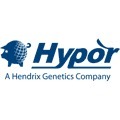 In July 2016 new feeding stations were installed at Hypor’s nucleus facility in Abernethy, Saskatchewan. With the replacement of the old stations, which provided a lot of important data for feed efficiency, the first 24 Pig Performance feeding stations of Nedap were deployed.
In July 2016 new feeding stations were installed at Hypor’s nucleus facility in Abernethy, Saskatchewan. With the replacement of the old stations, which provided a lot of important data for feed efficiency, the first 24 Pig Performance feeding stations of Nedap were deployed.
This first step of the project, executed in phases, was very successful and went according to plan. The final step in this project, planned in August 2016, is the installation of another 30 feeding stations at the nucleus facility.
Hypor is growing the number of pigs it tests by 25 percent with the addition of several Pig Performance feeding stations. “By increasing our feeding stations we’ll be able to collect more phenotypes and make faster genetic improvements for the whole swine industry,” says Hypor Director of Research and Development Abe Huisman.
The Nedap Pig Performance Test stations record the amount of feed intake and the weight of the animal each time the pig visits the feeder. “This is something new and exciting for the industry—traditionally pigs are weighed only five times between birth and the end of the testing period,” says Huisman.
Data from the feeding stations shows the difference in daily feed intake and the daily weight gain of individual pigs and will advance the ability Hypor has to select pigs that meet the U.S. and Canadian market demand for high feed efficiency later in the growing period.
“Feed costs account for 60 to 70 percent of the total cost of production,” says Huisman. “If we can make pigs a little more efficient, we’ll be able to help producers be more profitable.”
Hypor will use the data from the feeding stations to determine at what point a pig’s rate of daily gain slows down.
“We want to select the pigs that are lean and efficient at the end of the growing period as well at the beginning to stay in-line with the markets,” says Huisman. North American slaughter weights have steadily increased over the past 20 years.
To meet the market demand for lean, quality pork in heavier pigs, Hypor uses a real-time ultrasound device, versus a computed tomography (CT) scanner, to measure the marbling and muscle-to-fat ratio.
“The ultrasound device allows us to collect more data than we would using a CT scanner which is limited to use on pigs that weigh less than 100 kg,” says Hypor North America General Manager Luis Prieto. “The average live weight of market pigs is around 132 kg.”
Utilizing technological advances is one more way Hypor is able to serve North American pork producers. Hypor tests thousands of pigs in North America annually for individual feed intake, and provides two commercial sow lines and three boar lines for U.S. and Canadian customers. Hypor’s Magnus, Maxter and Kanto boar lines are selected on the ability to maintain feed efficiency longer in the growing period and to produce quality meat at heavier weights.

August 8, 2016 - Hypor


